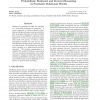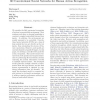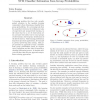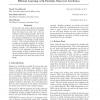115
click to vote
ICML
2010
IEEE
15 years 1 months ago
2010
IEEE
Many structured prediction tasks involve complex models where inference is computationally intractable, but where it can be well approximated using a linear programming relaxation...
127
Voted
ICML
2010
IEEE
15 years 1 months ago
2010
IEEE
Inference in graphical models has emerged as a promising technique for planning. A recent approach to decision-theoretic planning in relational domains uses forward inference in d...
102
click to vote
ICML
2010
IEEE
15 years 1 months ago
2010
IEEE
We consider the fully automated recognition of actions in uncontrolled environment. Most existing work relies on domain knowledge to construct complex handcrafted features from in...
94
Voted
ICML
2010
IEEE
15 years 1 months ago
2010
IEEE
Transfer learning can be described as the tion of abstract knowledge from one learning domain or task and the reuse of that knowledge in a related domain or task. In categorizatio...
109
Voted
ICML
2010
IEEE
15 years 1 months ago
2010
IEEE
A learning problem that has only recently gained attention in the machine learning community is that of learning a classifier from group probabilities. It is a learning task that ...
99
Voted
ICML
2010
IEEE
15 years 1 months ago
2010
IEEE
We introduce a novel graph kernel called the Neighborhood Subgraph Pairwise Distance Kernel. The kernel decomposes a graph into all pairs of neighborhood subgraphs of small radius...
99
Voted
ICML
2010
IEEE
15 years 1 months ago
2010
IEEE
This paper develops a generalized apprenticeship learning protocol for reinforcementlearning agents with access to a teacher who provides policy traces (transition and reward obse...
ICML
2010
IEEE
15 years 1 months ago
2010
IEEE
We describe and analyze efficient algorithms for learning a linear predictor from examples when the learner can only view a few attributes of each training example. This is the ca...
92
Voted
ICML
2010
IEEE
15 years 1 months ago
2010
IEEE
We develop a new algorithm, based on EM, for learning the Linear Dynamical System model. Called the method of Approximated Second-Order Statistics (ASOS) our approach achieves dra...
89
Voted
ICML
2010
IEEE
15 years 1 months ago
2010
IEEE
We address the problem of evaluating the risk of a given model accurately at minimal labeling costs. This problem occurs in situations in which risk estimates cannot be obtained f...




